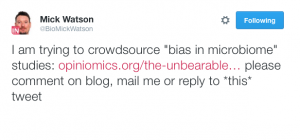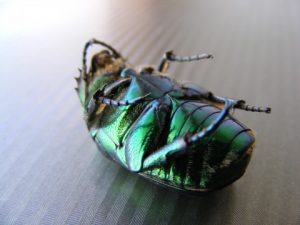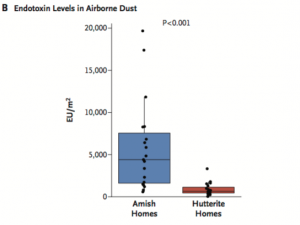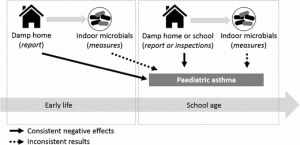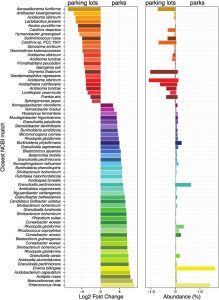So I just saw this Tweet @BioMickWatson can’t find paper I’m thinking of, but OTU calling software/algorithm matters a lot – David Baltrus (@surt_lab) August 6, 2016 So I went to Mick Watson’s site and saw this: This is my attempt to collate the literature on how easy it is to introduce bias into microbiome …
There is an interesting new open access paper on urban ecosystems out in Biology Letters: Exoskeletons and economics: indoor arthropod diversity increases in affluent neighbourhoods | Biology Letters No it is not directly about microbes but nobody’s perfect and many of the arthropods they look at are small and the story about biodiversity is (I …
So there is this new paper out in the New England Journal of Medicine: Innate Immunity and Asthma Risk in Amish and Hutterite Farm Children – NEJM It is quite interesting and is getting a bunch of press including Barnyard Dust Offers a Clue to Stopping Asthma in Children Amish kids help scientists understand why …
In light of the Cold Fire that started yesterday evening in the central valley of California, I started to wonder, ‘what happens to microbes?!’ I found myself in a literature click hole of fantastic papers that studied how fire impacted soil microbial communities in several different ecosystems. What surprised me most is how fast researchers …
I have some automated Google Scholar searches for MoBE related topics and recently a few theses came up in the searches and I thought I would post about them here Here is one: Indoor biological exposures : what can HVAC filter dust tell us? Author: Jennings, Wiley Charles from Kerry Kinney’s lab. Abstract: Because people in the US …
There is a recent review paper that may be of interest: Pediatric Asthma and the Indoor Microbial Environment | SpringerLink Abstract The global increase in the prevalence of asthma has been related to several risk factors; many of them linked to the “westernization” process and the characteristics of the indoor microbial environment during early life …
Quick post – paper of interest: Urban greenness influences airborne bacterial community composition Abstract Urban green space provides health benefits for city dwellers, and new evidence suggests that microorganisms associated with soil and vegetation could play a role. While airborne microorganisms are ubiquitous in urban areas, the influence of nearby vegetation on airborne microbial communities …
Got this by email: Registration to attend the third meeting of the National Academies of Sciences, Engineering, and Medicine’s committee on Microbiomes of the Built Environment: From Research to Application is now open! This meeting will be held at the National Academies’ Beckman Center Auditorium at the University of Irvine, California on October 17-18, 2016. …
Microbes in the air High throughput genomic sequencing of bioaerosols in broiler chicken production facilities – Kate M. O’Brien – Microbial Biotechnology (OA) Chronic inhalation exposure to agricultural dust promotes the development of chronic respiratory diseases among poultry workers. Poultry dust is composed of dander, chicken feed, litter bedding and microbes. However, the microbial composition …
There is a really nice new paper out in mSystems (full disclosure – I am on the Board of Editors of the journal). The paper is from Brent Stephens and sums up a recent presentation of his. See What Have We Learned about the Microbiomes of Indoor Environments? Abstract: The advent and application of high-throughput …
